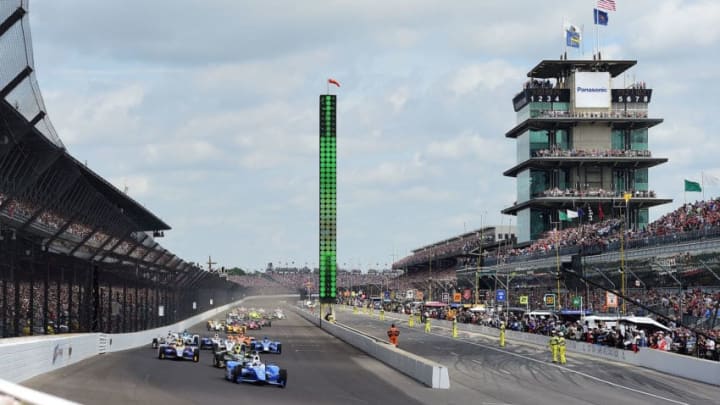The 2018 Indy 500 now has a confirmed 34 entries. Should the race feature bumping or should all cars get to start the race?
Last week, Jay Howard was confirmed as the 34th entry for the 2018 Indy 500. Since then, a small debate has gone on as to whether or not qualifying should feature bumping or if they should just let everyone start the race.
Marshall Pruett discussed this in a recent Racer.com editorial. In this piece, Pruett believes in the traditional starting field of 33. He also mentioned, though, that esteemed racing writer Robin Miller thinks otherwise.
Social media seems split on this as well. Indianapolis Motor Speedway president Doug Boles weighed in on it as well.
Here is a tweet regarding Pruett’s article.
#IndyCar could potentially have more than the traditional 33 cars on the grid at this year's #Indy500. But that doesn't mean it should, argues @marshallpruett https://t.co/OI84tGmzSd pic.twitter.com/aP33pRY0OX
— RACER (@RACERmag) March 29, 2018
There’s a case to be made for each side, so let’s examine both and come to a final verdict.
The case for Indy 500 bumping
Tradition, for one.
There is something to be said for all of the traditions of the Indy 500, and 11 rows of three is one of the biggest ones. While special circumstances has led to fields larger than that in the past, I can’t see of a single reason to have a larger field this year.
When teams pay their entry fee, they know what they are getting into. There is the possibility that after qualifying you load up the truck and go home. Sure, that doesn’t happen on the other stops of the IndyCar schedule, but everyone knows the rules.
It’s the Indy 500; it should be hard — all of it. It’s the biggest race in the world and everyone should have to earn their way into the show.
The case for no Indy 500 bumping
A series that is looking to grow shouldn’t turn anyone away.
The investment needed to get a car on the grid is pretty substantial. It takes well into six figures to even get a car to pit road. That kind of investment either comes through deep pockets or sponsorship — usually both.
So if a series is intent on growing, why turn away potential drivers, teams and, most importantly, sponsors? How can a series that wants to bring new sponsors to the sport tell them that there is a chance that their brand won’t be seen on race day?
And besides, does starting more than 33 cars really hurt anything? The 1979 and 1997 races both had 35 starters, and the 1933 race had a whopping 42 cars in the field.
Times change, and tradition has been bent before. It can be argued that a growing series could extend a little goodwill towards those parties who are looking to make an investment by allowing their entries into the field.
That’s just good business.
The verdict
All sports are businesses. But with any sport, the business end of it stops when the competition begins.
More from IndyCar
- IndyCar: Two teams with no drivers confirmed for 2024
- IndyCar: Chip Ganassi Racing news hints Alex Palou announcement
- IndyCar: ‘Addition by subtraction’ could pay off in a big way
- Team Penske should make a bold driver signing for 2024
- IndyCar: 5 teams that still have open seats for 2024
The reason we compete is to find out who is the best on a particular day. It’s to identify both winners and losers. One of the things that cheapens competition is when the rules are altered in order to pacify a certain group of people.
In the end, the Indianapolis 500 is a competition. If the rules call for 33 entries, that’s how many should be in the field.
True competition is posting a qualifying time and living with the result. If your car is one of the 33 fastest, then line it up and race. If not, load up the transporter and figure out a way to go faster before next year.
Next: Top 10 most unbreakable records across Formula One, NASCAR and IndyCar
Sure, that’s brutal. But that’s also big boy competition, which is what the Indy 500 is all about. In other words, bump away.
